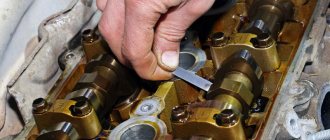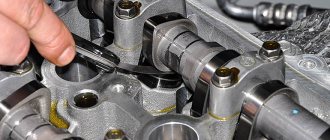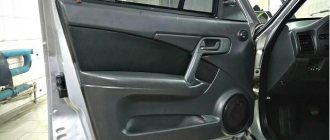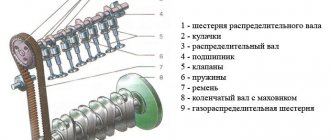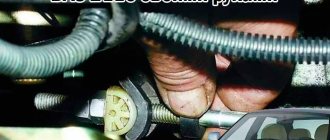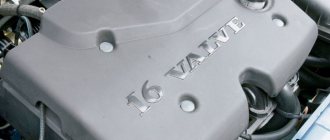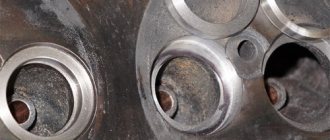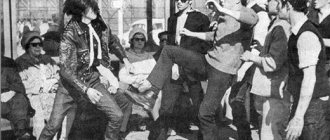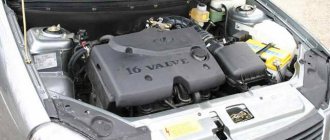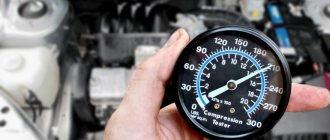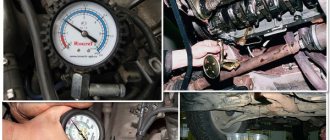During engine operation, all parts change their geometric dimensions due to thermal expansion, which is not always precisely predictable. This problem also concerns the valve drive of the gas distribution mechanism in four-stroke engines. Here it is important to very accurately and timely open and close the intake and exhaust channels, acting on the end of the valve stem, which is difficult in conditions of expansion of both the stems themselves and the entire head of the block.
Designers are forced to leave thermal gaps in the joints or resort to installing units for their mechanical compensation.
The role of valves and valve timing in an engine
One of the most important characteristics of an engine when it comes to its maximum power output with acceptable fuel consumption is filling the cylinders with fresh mixture. It enters the working volume through the valve system, and they release the exhaust gases.
When the engine operates at significant speeds, and with some assumption they can be considered both maximum and minimum idle speeds, the masses of gas passing through the cylinders begin to manifest their aerodynamic properties, inert and others related to the efficiency of combustion and thermal expansion.
The accuracy and optimality of selecting fuel energy and converting it into mechanical energy depend on the timely supply of the mixture to the working area, followed by its equally prompt removal.
On the subject: PCV valve or how crankcase ventilation works
The moments of opening and closing of the valves are determined by the phase of movement of the piston. Hence the concept of valve timing.
At any time, and for a motor this means the angle of rotation of the crankshaft and a specific stroke of the engine within the cycle, the state of the valve is determined quite clearly. It can only depend on the speed and load within strictly standardized limits set by the phase adjustment system (phase regulators). They are equipped with the most modern and advanced engines.
How should the elements work?
The operation of a 4-stroke engine includes 4 cycles.
Each cycle has its own purpose:
- Intake - the intake valve opens and the fuel mixture is supplied to the cylinder.
- Compression - the valves are closed, the fuel mixture is compressed.
- Power stroke - the valves are closed, the burning mixture expands, its energy is directed to move the pistons.
- Exhaust - the exhaust valve opens, exhaust gases are removed.
For the motor to operate efficiently, the clearances must be properly adjusted.
Signs and consequences of improper clearance
Ideally, the precision of the valves ensures zero clearance. Then the valve will clearly follow the trajectory specified by the camshaft cam profile. It has a rather complex shape that is carefully selected by the motor developers.
But this can only be realized with the use of hydraulic gap compensators, which, depending on the specific design, are also called hydraulic pushers and hydraulic supports.
In other cases, the gap will be small, but quite finite, depending on temperature. ICE developers experimentally and by calculation determine what it should be like initially, so that in any conditions, changing the gaps does not affect the operation of the engine, causing damage to it or reducing its consumer qualities.
Big gap
At first glance, increasing valve clearances looks safe. No thermal changes will reduce them to zero, which is fraught with problems.
But the growth of such reserves does not pass without a trace:
- the engine begins to make a characteristic knock, which is associated with increased acceleration of parts before coming into contact;
- shock loads lead to increased wear and chipping of metal surfaces, the resulting dust and chips disperse throughout the engine, damaging all parts that are lubricated from a common crankcase;
- The valve timing begins to lag due to the time required to select the gaps, which leads to deterioration in performance at high speeds.
It is interesting that a loudly knocking engine with huge gaps can pull perfectly at low speeds, acquiring, as they say, “tractor traction.” But you cannot do this deliberately; the motor will quickly be worn out by products from surfaces subject to shock loads.
Small gap
Reducing the gap is fraught with much faster and irreparable consequences. As it warms up, the insufficient clearance will quickly become zero, and interference will appear in the joint of the cams and valves. As a result, the valve discs will no longer fit tightly into their seats.
The cooling of the valve plates will be disrupted; according to calculations, they dump some of the heat into the metal of the head during the closing phase. Even though the valves are made from heat-resistant steels, they will quickly overheat and burn out using the high temperature and available oxygen. The motor will lose compression and fail.
Video: how to adjust gaps on front-wheel drive Ladas
In general terms, the design of the gas distribution mechanism and the procedure for adjusting the valve clearance on a diesel engine are the same as on a gasoline engine.
There is an opinion that after installing gas equipment on the engine, it is necessary to increase the thermal clearance in the valves. This is explained by the higher combustion temperature of the gas. In fact, this is not required. The features of ignition and combustion of the gas mixture in the cylinder are taken into account by changing the ignition angle, and the process of filling and removing gases from the cylinder does not differ from that when the engine is running on gasoline.
Adjusting valve thermal clearances
Some engines, during normal operation, tend to increase valve clearances as a result of wear. This is a safe phenomenon, since it is difficult not to notice the knocking that has begun.
It’s much worse, and unfortunately this is how most motors behave when the gaps decrease over time. Therefore, to avoid zeroing the gaps and burnouts of the plates, adjustments must be made strictly according to the factory regulations.
We use a probe
The easiest way is to remove the valve cover, move the cam away from the valve being tested and try to insert the flat feeler gauge from the kit into the gap.
Typically, the thickness of the probes has a pitch of 0.05 mm, which is sufficient for measurements with acceptable accuracy. The size of the gap is taken to be the thickness of the largest probe that still passes into the gap.
Using a staff and indicator
On some motors, usually those with rocker arms (levers, rockers) in the drive mechanism, it is possible to install a device in the form of a rack, on which sockets are provided for mounting a precision dial indicator.
By bringing its leg to the lever opposite the stem, you can swing the rocker, free from the cam, manually or with a special fork, reading the readings on the indicator scale with an accuracy of about 0.01 mm. Such precision is not always necessary, but adjustment becomes much more convenient.
What to do if you need HBO
The propane-butane mixture has a much higher octane number than traditional gasoline for general use. Accordingly, it burns more slowly, warming up the exhaust valves during release. The gaps begin to decrease much more than the engine developers envisioned, assuming the use of gasoline.
You need to know this: How to understand that a valve has burned out: causes, signs and consequences
To avoid premature burnout of the plates and sockets, the gaps during adjustments are set to be larger. The specific value depends on the engine, usually the addition is 0.15-0.2 mm.
More is possible, but then you will have to put up with noise, reduced power and increased wear of the gas distribution mechanism when operating at partial loads. The best solution would be to use gas engines with hydraulic compensators.
Where to install the camshaft
There are different options for the location of the camshaft in the engine and the design of the mechanisms that transmit pressure from the surface of the camshaft to the valve stem. However, the increase in the speed of modern passenger engines has led to the fact that a scheme with the location of the camshaft in the engine head - an overhead design - has become established everywhere in them. The proximity of the camshaft to the valves makes it possible to increase the rigidity of the system, and therefore improve the accuracy of operation.
The prototype of the first Zhiguli VAZ-2101, the Italian Fiat-124, had a solid and reliable, but no longer modern engine design with a lower camshaft. Soviet engineers decided that the engine of our new car should keep up with the times, and together with the Italians they modernized it by moving the camshaft to the head of the block.
The lower camshaft design is easy to maintain, but lacks rigidity when operating at high speeds.
The overhead camshaft timing mechanism is much more rigid due to the absence of long pushrods
An example of valve adjustment on a VAZ 2107
The VAZ-2107 is equipped with a classic engine with valve drive through rockers from a single camshaft. The gaps increase over time, the design is not perfect, so adjustment is required approximately every 20 thousand kilometers.
You can perform this operation yourself; the skill is developed quite quickly. The only consumables you will need are a valve cover gasket; you should not try to reuse it or with sealant, the cover is weak, the fasteners are unreliable, and the engine will quickly become covered with dirt from leaking oil.
For work, it is highly advisable to purchase a set of a rack and an indicator. The advantages are known to those who work with engines professionally and are able to appreciate the difference between a precision tool and a conventional feeler gauge.
The operating procedure for the cylinders and camshaft cams is engraved on the rack itself, and is also available in any VAZ manual or repair book.
- The fourth cylinder is installed at the top dead center of the compression stroke, after which valves 6 and 8 are adjusted. The gap is measured with an indicator, after which the lock nut is loosened and the calculated wear compensation is introduced using the adjusting bolt.
- Next, the operations are repeated for all valves, turning the crankshaft sequentially by 180 degrees, or it will be 90 along the camshaft. Cam numbers and rotation angles are indicated on the rack.
- If a feeler gauge is used, it is inserted into the gap and tightened with an adjusting bolt and lock nut. They press it in such a way that it is pulled out of the gap with little effort, this will correspond to the standard gap of 0.15 mm.
Taking advantage of the fact that the cover is removed, it will be practical to check the chain tension and the condition of the tensioner, its shoe and guide. If you need to repair something or tighten the chain, then the valves should be adjusted after completing all procedures with the chain.
Preparation
Before starting work, it is better to thoroughly wash the car body and clean the engine compartment from dust and dirt, so that nothing unnecessary gets into the engine after removing the cylinder head cover. Then it is very advisable to place the car on the most flat surface possible, tighten the parking brake and place chocks under the wheels. It would be useful to have good and uniform lighting. If the latter is not enough, get additional light sources.
It is not at all necessary to buy such stops; you can easily make them yourself
Next, you need to wait until the engine cools down to the recommended temperature (usually 15–25 °C) so that the measurements are as accurate as possible. Sometimes experienced craftsmen undertake “hot” adjustments, taking into account certain corrections for the increased engine temperature. But engines are different, with their own nuances and amendments, so it’s better to wait. Free time can be used to replace filters, check optics, etc.
The thermal clearances of the valves can also be adjusted with the cylinder head removed. Here, for whomever which scheme of work is more convenient, this method cannot be considered wrong. Just remember that when installing the cylinder head on the machine and broaching, the gaps may shift either to the plus or minus of the required values. Therefore, it is better to play it safe and double-check.
